Maps of the Antique
Mediterranean Sea
 The Egyptians The Egyptians
 Overview Overview
 Some dates Some dates
 Archaeological sites Archaeological sites
 Egyptian Art Egyptian Art
 World's museums World's museums
 Coinage Coinage
 Language and Writing Language and Writing
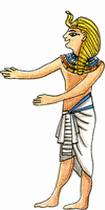
Photo credit:
 Alain Guilleux Alain Guilleux
Photos Egypte
 Association Association
Les amis de l'Egypte ancienne
All rights reserved.
|
EGYPTIAN ART
The perfection reached by the ancient Egypian craftsmen in every form of art certainly explains partly the fascination of this civilization. This art is surprising in many respects. First because of its specificity: even without any historical education, anyone recognizes immediately that a fresco, a statue, an amulet is Egyptian. Secondly because of the longevity of these specificities: because – conversely - the simple amateur will hardly make the difference between an Old Kingdom and a Greco-roman low-relief, despite the two-millenia gap between them! When you think how easy it is to place in its century a work from the Renaissance or the 19th century, this seems incredible..
Of course, there are some stylistic differences between the periods. And of course, there is one exceptional time, that of Akhénaton, the "heretic Pharaoh" , who imposed in a few years a style, a morphology for human representation which may be recognized very easily… but as soon as he disappeared, Egypt returned immediately to the strictest classicism. .
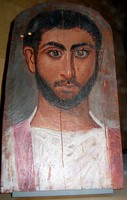 It appears that the artistic expression was a component of Egyptian stability, since even the invaders, Persians, Greeks or Romans, never broke the tradition, and the temples they built preserved the broad outlines of the Pharaonic style. The masks of the “golden” mummies and the Fayum portraits are a noticeable exception. It appears that the artistic expression was a component of Egyptian stability, since even the invaders, Persians, Greeks or Romans, never broke the tradition, and the temples they built preserved the broad outlines of the Pharaonic style. The masks of the “golden” mummies and the Fayum portraits are a noticeable exception.
Right: a Fayum portrait - © Association "Les amis de l'Egypte ancienne"
Even the influence of foreign arts, that the Egyptians were not unaware of, remains unimportant. Unless our vision is deformed, since the Egyptian art we know is most of the time a funerary one ? Of course, daily life is represented, mainly in the tombs of craftsmen and private figures, and there were vogues, as some appear for the wigs from various times or the furniture which are represented, but the tradition never lost its influence over the centuries.
For as much, there is no doubt that sculptors of low reliefs, of statuettes or colossal statues, painters, architects, jewellers, calligraphers, writers, poets or musicians had a sense for creativity… but it remained generally unexpressed. .
Many Internet sites are dedicated to the various forms of art which we mentioned here. We will thus limit ourselves to the broad outlines, and later, you may look for more on the web!
A simple and clear art
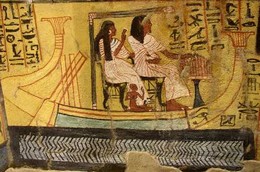 The Egyptian art gives a feeling of order and balance: the forms are clearly delineated, arranged, and underlined by flat coloured areas. The same applies for writing: the hieroglyphs which make up a word are sometimes moved only to make the word pleasant to look at. The conscience of the craftsmen deserves also to be underlined :they reproduce accurately and engrave the hieroglyphs on the temples with a profusion of details which would seem useless for reading. The Egyptian art gives a feeling of order and balance: the forms are clearly delineated, arranged, and underlined by flat coloured areas. The same applies for writing: the hieroglyphs which make up a word are sometimes moved only to make the word pleasant to look at. The conscience of the craftsmen deserves also to be underlined :they reproduce accurately and engrave the hieroglyphs on the temples with a profusion of details which would seem useless for reading.
© Alain Guilleux "Une promenade en Egypte"
The prospect is very basic (several characters are often superimposed to give a notion of various grounds), and when a difference of size exists between the figures, it is only to underline their social status: the more preeminent, the taller. The shapes, the postures, the symbols and even the choice of colors remain very codified.
The funerary arts are obviously very subjected to religious traditions: the purpose is not to show a lifelike portrait of the character (that nobody will see anyway, since in a tomb), but to symbolize it in its youth, its force and all its qualities.
This explains the iconography: an active face (turned sideways), an expressive eye (front view), a vigorous chest (front view), a confident step (side view).
A historical summary
Old Kingdom
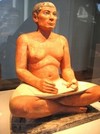 As of the beginning of the Old Kingdom, the Egyptians knew the techniques of ceramics, copper and gold metallurgy, stone working. Their skill appeared in the perfection of realistic statues (the scribes with glass inlaid eyes), initially of small size then increasingly taller, showing life-size high-ranking persons … and far beyond, since the gigantic Sphinx of Gizeh has to be mentioned here. As of the beginning of the Old Kingdom, the Egyptians knew the techniques of ceramics, copper and gold metallurgy, stone working. Their skill appeared in the perfection of realistic statues (the scribes with glass inlaid eyes), initially of small size then increasingly taller, showing life-size high-ranking persons … and far beyond, since the gigantic Sphinx of Gizeh has to be mentioned here.
Of course, we have to mention also the painted low-reliefs, the architectural evolution of the pyramids, first groping, then reaching for perfection. Tombs became covered with hieroglyphic inscriptions where esthetics is already sophisticated.
The scribe of the Louvre - © Association "Les amis de l'Egypte ancienne"
The Middle Kingdom
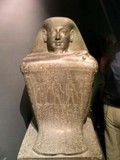 After a troubled period (the first intermediate period), the Middle Kingdom hastened to revive the artistic traditions of the glorious past of the first dynasties. The artists expressed again their talent in statues, temples, inscripted walls, gold, sometimes stone inlaid jewellery.
The “cube statues" appeared, on which long texts could be written beneath the character, and sarcophagi became abundantly decorated. Wood was more often used. Artefacts made of glazed ceramics appeared - often blue-coloured (called "egyptian faience").
After a troubled period (the first intermediate period), the Middle Kingdom hastened to revive the artistic traditions of the glorious past of the first dynasties. The artists expressed again their talent in statues, temples, inscripted walls, gold, sometimes stone inlaid jewellery.
The “cube statues" appeared, on which long texts could be written beneath the character, and sarcophagi became abundantly decorated. Wood was more often used. Artefacts made of glazed ceramics appeared - often blue-coloured (called "egyptian faience").
Right: a cube statue
© Association "Les amis de l'Egypte ancienne"
the New Kingdom
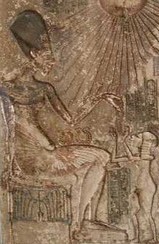 After the second intermediate period, art revived once more. Temples spread all over Egypt, with gigantic structures, in an extreme prosperity and activity. The reign of Akhenaton, as we said, was a political, but also artistic episode: the characters adopted flexible, androgynous shapes. The return to the traditions was then sudden !
After the second intermediate period, art revived once more. Temples spread all over Egypt, with gigantic structures, in an extreme prosperity and activity. The reign of Akhenaton, as we said, was a political, but also artistic episode: the characters adopted flexible, androgynous shapes. The return to the traditions was then sudden !
Left : Art in the time of Akhenaton
© Alain Guilleux "Une promenade en Egypte"
All later periods endeavoured to maintain or retrieve the traditions of Egyptian splendour, with more or less success. The last “foreign” dynasties, the Greeks, the Romans brought their personal touch (mainly on the funerary masks, made of glazed beads, of gold coloured wood or plaster, then using painted wood panels) without much deviation from tradition.
What about collectors?

Of course, some fortunate collectors are able to acquire pieces with high artistic value. For the others, there remain some relatively affordable fields provided you keep some modesty as for their quality, like small funerary statuettes (Ushebtis), amulets showing a god or symbols (Wadjet eye), engraved scarabs, some ptolemaïc terracottas, plain jewels (glazed beads necklaces, etc.).
Numismatists may find easily ptolemaic coins (greek in style) or of the Roman time (...roman in style !), with nice portraits of rulers.
|













 Alain Guilleux
Alain Guilleux  It appears that the artistic expression was a component of Egyptian stability, since even the invaders, Persians, Greeks or Romans, never broke the tradition, and the temples they built preserved the broad outlines of the Pharaonic style. The masks of the “golden” mummies and the Fayum portraits are a noticeable exception.
It appears that the artistic expression was a component of Egyptian stability, since even the invaders, Persians, Greeks or Romans, never broke the tradition, and the temples they built preserved the broad outlines of the Pharaonic style. The masks of the “golden” mummies and the Fayum portraits are a noticeable exception.  The Egyptian art gives a feeling of order and balance: the forms are clearly delineated, arranged, and underlined by flat coloured areas. The same applies for writing: the hieroglyphs which make up a word are sometimes moved only to make the word pleasant to look at. The conscience of the craftsmen deserves also to be underlined :they reproduce accurately and engrave the hieroglyphs on the temples with a profusion of details which would seem useless for reading.
The Egyptian art gives a feeling of order and balance: the forms are clearly delineated, arranged, and underlined by flat coloured areas. The same applies for writing: the hieroglyphs which make up a word are sometimes moved only to make the word pleasant to look at. The conscience of the craftsmen deserves also to be underlined :they reproduce accurately and engrave the hieroglyphs on the temples with a profusion of details which would seem useless for reading.
 As of the beginning of the Old Kingdom, the Egyptians knew the techniques of ceramics, copper and gold metallurgy, stone working. Their skill appeared in the perfection of realistic statues (the scribes with glass inlaid eyes), initially of small size then increasingly taller, showing life-size high-ranking persons … and far beyond, since the gigantic Sphinx of Gizeh has to be mentioned here.
As of the beginning of the Old Kingdom, the Egyptians knew the techniques of ceramics, copper and gold metallurgy, stone working. Their skill appeared in the perfection of realistic statues (the scribes with glass inlaid eyes), initially of small size then increasingly taller, showing life-size high-ranking persons … and far beyond, since the gigantic Sphinx of Gizeh has to be mentioned here.  After a troubled period (the first intermediate period), the Middle Kingdom hastened to revive the artistic traditions of the glorious past of the first dynasties. The artists expressed again their talent in statues, temples, inscripted walls, gold, sometimes stone inlaid jewellery.
The “cube statues" appeared, on which long texts could be written beneath the character, and sarcophagi became abundantly decorated. Wood was more often used. Artefacts made of glazed ceramics appeared - often blue-coloured (called "egyptian faience").
After a troubled period (the first intermediate period), the Middle Kingdom hastened to revive the artistic traditions of the glorious past of the first dynasties. The artists expressed again their talent in statues, temples, inscripted walls, gold, sometimes stone inlaid jewellery.
The “cube statues" appeared, on which long texts could be written beneath the character, and sarcophagi became abundantly decorated. Wood was more often used. Artefacts made of glazed ceramics appeared - often blue-coloured (called "egyptian faience").  After the second intermediate period, art revived once more. Temples spread all over Egypt, with gigantic structures, in an extreme prosperity and activity. The reign of Akhenaton, as we said, was a political, but also artistic episode: the characters adopted flexible, androgynous shapes. The return to the traditions was then sudden !
After the second intermediate period, art revived once more. Temples spread all over Egypt, with gigantic structures, in an extreme prosperity and activity. The reign of Akhenaton, as we said, was a political, but also artistic episode: the characters adopted flexible, androgynous shapes. The return to the traditions was then sudden ! 